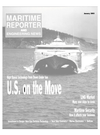
Danger on the High Seas
A tale of survival could best describe John S. Burnett's experience onboard his sloop Unicorn in January 1992.
Sailing solo across the South China Sea to Singapore — one of the busiest shipping lanes in the world — Burnett was attacked by pirates. However, with luck on his side. Burnett, who is a journalist and professional seaman, survived.
Following this harrowing experience, Burnett was prompted to investigate further the world of modern-day piracy — world that is as shocking as it is terrifying.
Dangerous Waters: Modern Piracy and Terror on the High Seas (Dutton.
$24.95), provides an investigative look into maritime terrorism on the world's oceans. Burnett holds readers with his exploration of resurgence of piracy and 50 also explains why this subject is increasing at such a rapid rate. It is a littleknown fact, which Burnett reveals, that off the coasts of nearly all continents, pirate attacks worldwide amount to several thousand each year. Since approximately 95 percent of the world's commerce is transported via ship, including 60 percent of the world's crude oil, it is therefore easy to suspect the potential for an economic and environmental disaster is rather high. Often depicted as high-class rumrunners by the movie industry, pirates are anything but. They can range anywhere from local seamen looking for a quick and easy fix. to highly- experienced guerillas, rogue military units or former seafarers recruited by high-level crime organizations. Often armed with sophisticated weaponry such as machetes, assault rifles and grenade launchers, pirates move about the high seas via speedboats and fishing boats in search of the world's largest. lucrative vessels, mainly s u p e r t a n k e r s , cargo ships and cruise ships — along coasts or international waters. According to Burnett, this is a problem that exists worldwide. "There is not a shipping lane, a navigable strait, and important canal that is safe from those determined to take over a ship." says Burnett.
Highlighted in this true account is the author's journey aboard a Very Large Crude Carrier (VLCC) as it transits the most pirated waters in the world en route to a refinery in Singapore from the oil fields of the Persian Gulf. VLCC's.
which weigh in excess of 300.000 tons.
are able to carry approximately two million barrels of crude. Yet, despite their mammoth size, are exceptionally vulnerable to, and have been, frequent targets of pirates. Burnett also offers an in-depth explanation of a pirate attack onboard oil tanker Valiant Carrier in 1992 — a time when piracy had not reared its head as a high concern.
Burnett outlines the assault on the ship's master and his family and how it fueled the creation of the Piracy Reporting Center, which transmits daily alerts to ships worldwide. An in-depth discussion as to why, despite heavily trafficked shipping lanes, these attacks still occur - leaving crews isolated and vulnerable.
Circle 51 on Reader Service Card
Other stories from January 2003 issue
Content
- Alaska Awards Metlakatla Ferry Contract to Conrad page: 8
- King Named CEO for VT Halter Marine page: 8
- Halmatic Pilot Boats for Spain's Atlantic Coast page: 10
- Bollinger Delivers Ms. Sara Jane page: 11
- Air-to-Sea Technology Transfer page: 12
- Southbury LES:"Outages are Not Acceptable" page: 15
- Nera Introduces F33 page: 18
- Sending Screws, Pistons and Lube Oil via Satellite page: 19
- SeaWave Makes Maritime Communication Seamless page: 19
- The Maritime Transportation Security Act 101 page: 20
- Underwater Intervention 2003 Set for New Orleans page: 24
- Cygnus Thickness Gauge Designed for VideoRay page: 25
- Halmatic Building World's Tallest Yacht Mast page: 26
- To the North, South And A Little Island Sheltered page: 27
- A New England Shipyard Comes of Age page: 32
- Derecktor Expansion in Bridgeport Extends Capabilities page: 34
- Price, Quality, Schedule page: 35
- Manufacturing Better Bearings for the Marine Industry page: 36
- Old Dominion Gets New Research Vessel page: 37
- Speed to Spare page: 38
- LSA Enjoys Strong Orderbook page: 40
- Aircraft Carrier of the Future page: 43
- Cummins Introduces the QSK60 page: 44
- Emission-Reduction Test a Success page: 44
- AMSC Passes Milestone page: 44
- Workboat 2002 Round-Up Bollinger to USCG: 50 Boats and Counting page: 46
- Scanjet's Tank Cleaning System Reduces Vessel Turnaround Time page: 46
- Alfa Laval Offers New Plate Heat Exchanger Steam Heater Line page: 48
- Danger on the High Seas page: 50
- Market Report: Long-Term Healthy LNG Ship Demand page: 51
- Thales Prepares to take the Market by Storm page: 52

